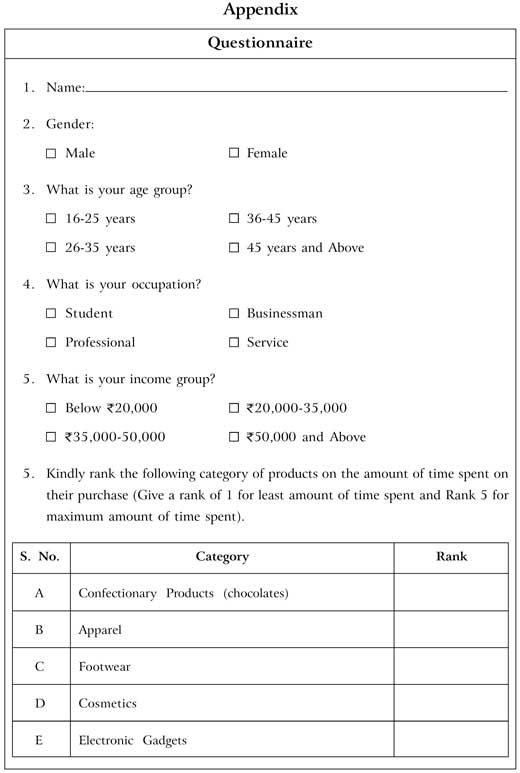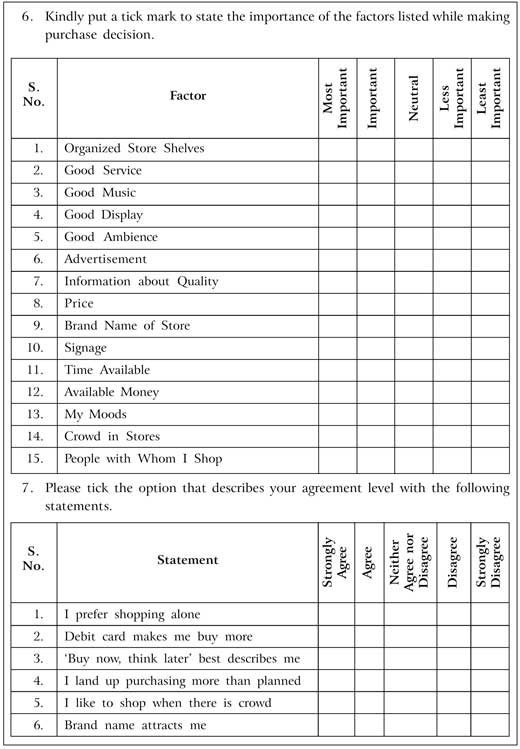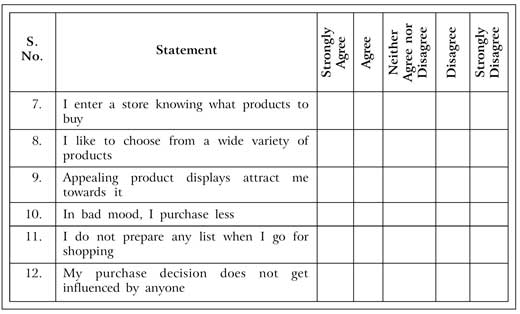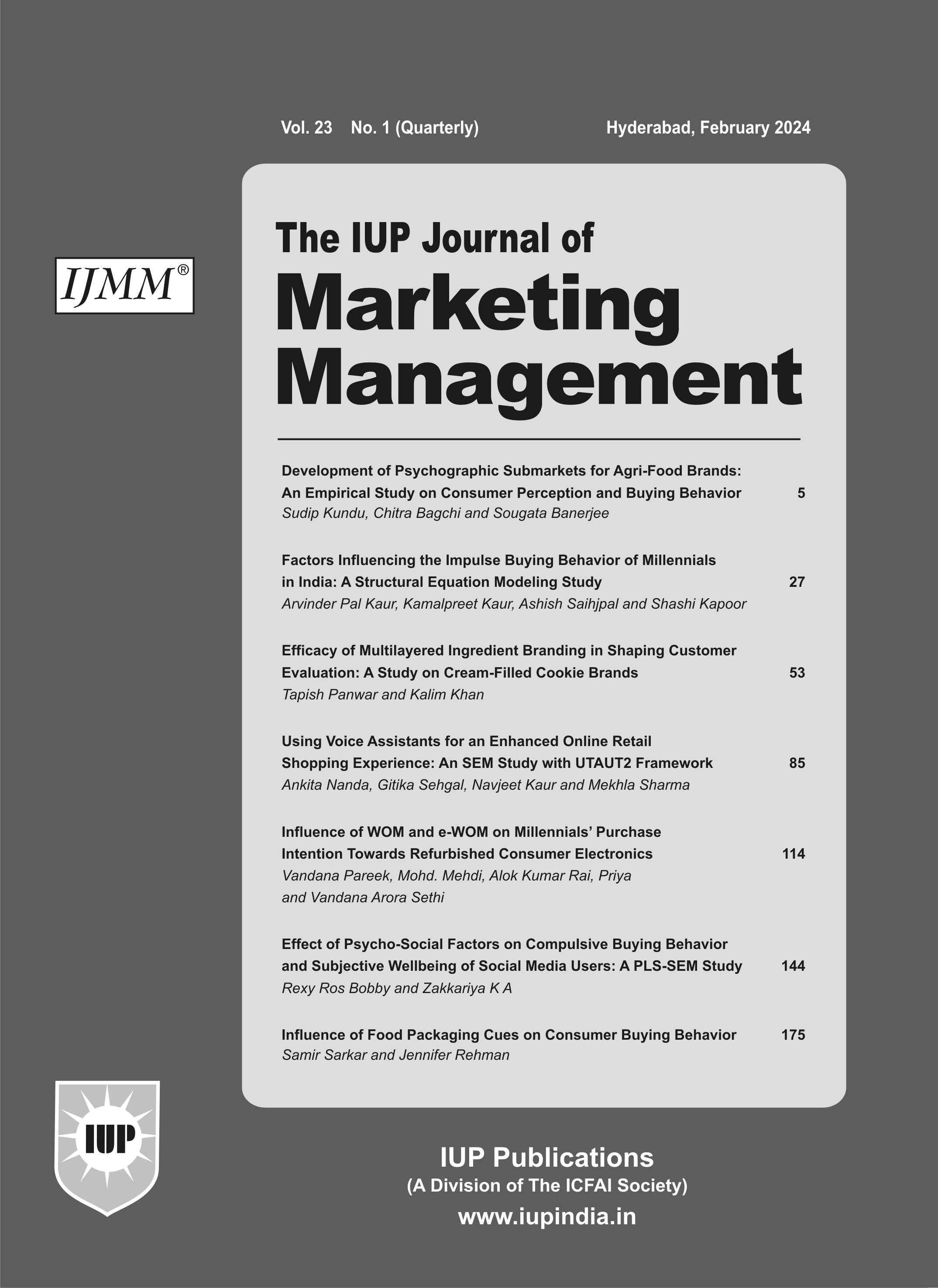
Feb'18
The IUP Journal of Marketing Management
Archives
A Study of Factors Affecting Customer Shopping Behavior
Rekha Attri
Assistant Professor,
Jaipuria Institute of Management,
Indore, Madhya Pradesh. India.
E-mail: rekha.attri@jaipuria.ac.in
Vinay Jain
Student,
Core Business School,
Indore, Madhya Pradesh, India.
E-mail: jain.vinay98@gmail.com
Marketers for long have been keen on understanding what drives the purchase behavior of the customers. The retail formats and the product assortments at these retail outlets are continuously changed and upgraded keeping in mind the changing customer tastes and the way they shop. Purchase decisions made by customers are influenced by multiple attributes. These attributes can range from store atmospherics, mood of the customer, product display, money available with the customers, brand name, etc. to name just a few. Fifteen statements related to the purchasing behavior of the customers were framed to study the demographic purchase behavior of the respondents. 113 respondents were reached out in Indore from January to March 2017. Store atmospherics, customer personality, marketing communications, service, retail outlet perceptions, availability of time and display at store are the seven factors which have been found to significantly affect the customer purchase behavior.
Introduction
Purchases made by customers are triggered by seeing the product and relating the same to the promotional messages to which the customer was previously exposed to. Emotions and feelings play a decisive role in such purchases and marketers tend to exploit this want of the customer for instant gratification. Factors like advertisement of the product, quality, price, time and money available with the shopper, brand name, product displays in store, moods of the customers, crowd in the store, company of the customer with whom he/she is shopping and the variety of products from which a customer has to choose from affect the buying decision of the customers. This paper attempts to study the factors affecting the shopping behavior of the customers.
Literature Review
Graa and elKebir (2011) stated that situational factors like store environment (atmosphere, design and employee assistance), time pressure and perceived crowding affected the buying behavior of the customers. Elements like music, light and display of the products also affected the customer behavior towards the products. It was further established that the more time a customer spent in the store, the probability of buying increases. Perceived crowding acted negatively on both the emotional state and the purchasing decision of the customer. Milliman (1982) studied the effect of background music on in-store shopping behavior. The results indicated that the pace of the in-store traffic flow was significantly slower with slow tempo music than for the faster tempo music. Further, higher sales volume were consistently associated with slower tempo musical selections and the faster tempo music was found to result in lower sales volume, thereby pointing towards the fact that when customers spend more time at the store they end up purchasing more.
Khan et al. (2014) categorized various factors affecting customer buying decision as (a) External Stimuli (promotions and advertising, store displays, buying frequency, atmosphere); (b) Internal Perceptions (emotion, lifestyle, money, time pressure and personality); (c) Buying Behavior (price, payment and the time of purchasing); and (d) Demographic Variables (age, gender, income, occupation, marital status, etc). It was also stated that the products which are related to pleasure were bought under impulse buying and not the products which accomplished practical needs. The atmospheric factors like aroma, style, attractive colors, interior design, display of merchandise, point of sale promotions grabbed buyers' attention and set up their mood to buy the products. Consumer characteristics which include mood, gender, shopping enjoyment and age also influenced customer buying behavior. Advertisements were found to play an important role in building the brand image in the eyes of the customers. Youn and Faber (2000) believed that the customer purchase behavior is influenced by internal state of the customers such as customer wellbeing, social potency, achievement, social closeness, stress reaction, alienation, aggression, control, harm avoidance, traditionalism and absorption.
The customer experiences which involve the level of interactions with the salespeople, store atmosphere, merchandise display, aroma, lighting and background music also were found to affect customer shopping behavior (Bashar et al., 2013). Cobb and Hoyer (1986) studied in-store customer decision making with or without some intent to purchase. Factors such as work, leisure time pressures, geographic mobility, a rise in number of two-career households and greater discretionary income were reasons behind consumers taking less time and effort in purchase planning. Stern (1962) studied the distinguishing factors between impulse purchasers and partial planners. Their study revealed that planners viewed product image and performance as the key factors in the purchase decision and retailers were unable to influence this group in the store environment.
Brand preferences have been found to be established in customers from a very young age of 15 years and marketers need to be aware of this reality in order to acquire and retain this customer segment (Meyer, 2001). Taylor and Cosenza (2002) studied the mall shopping behavior and clothing choice of later aged female teens. The research highlighted that for this segment of customers making a right clothing choice was important from a social affiliation and social influence position. The brand fit, look and style were the important attributes considered during the apparel choice. The mall composition and the excitement in the shopping venue were an important criteria of selecting the place to shop by this segment of customers. Fit, Style and Look were the important attributes assessed while shopping for clothing. Rich and Jain (1968) stated that social class and lifestyle of the customers can be used as predictors by the marketers to understand the shopping behavior of the customers. Interpersonal influences were also found to play an important part in shopping decisions. Pleasant store atmosphere, display and excitement were found to be the reasons behind shopping by women of upper-middle, lower-upper and upper-upper classes. The life cycle of the customer was not found to have any effect on the enjoyment of shopping for clothing and household items.
Bawa and Ghosh (1999) studied the factors which accounted for the variation in the shopping behavior for groceries across households. Their findings indicated that household characteristics influenced customer shopping behavior by affecting both number of trips and expenditure. Dickson and MacLachlan (1990) studied the correlation between the store avoidance behavior and the social distance (measured by the social class variables) of the customers. Their research concluded that customers belonging to a particular social class avoided those stores which were perceived to be socially distant from themselves.
Mulligan (2010) studied the consumer demand and multipurpose shopping behavior. The researcher demonstrated how customers patronized those firms which served to fulfil the multiple needs of the customers.
Objective
The study is focused on achieving the following objectives:
- To study the demographic purchase behavior of the respondents.
- To study the various factors influencing the buying behavior of people.
- To study the time spent while purchasing different product categories.
Data and Methodology
Based on the review of the literature, a self-developed questionnaire was used to gather deeper understanding about the purchasing behavior of people through an exploratory research. 113 respondents were reached out in Indore from January to March 2017. Out of the 113 responses collected, 13 responses were discarded due to incomplete information. Factors identified from literature review like brand preference, time availability, mood of the people, store ambience, etc. which normally affect the buying decision were included in the questionnaire. 15 statements relating to the purchasing behavior of the customers were framed to study the demographic purchase behavior of the respondents. The final data collected was analyzed by using SPSS 17.
The demographics of the respondents for this study were as follows:
- Gender: Males (52%) and Females (48%).
- Age Group: 16-25 years (33%); 26-35 years (21%); 36-45 years (26%); 45 years and above (20%).
- Income Group (Monthly): Below 20,000 (37%); 20,000-35,000 (21%); 35,000-50,000 (17%); Above 50,000 (25%).
- Occupation: Students (24%); Businessmen (21%); Professionals (25%); Service (30%).
Results and Discussion
The respondents were asked to rank the various category of items purchased based on the time they spent on deciding on the purchase of those products. A rank of 1 indicated least amount of time spent and a rank of 5 indicated that the customer spent most amount of time in deciding to purchase that product.
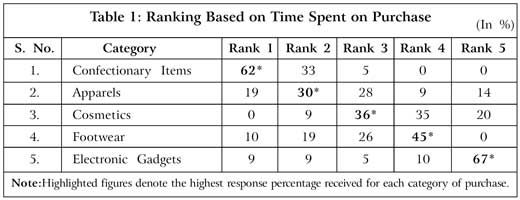
As seen in Table 1, the highest number of customers (62%) ranked purchase of confectionary items as rank 1, indicating that they spent least amount of time on purchase of these items. Shopping for apparels received the highest percentage response for rank 2 (30%) which suggests that the amount of time spent while purchasing apparels is more than that spent while purchasing confectionary items. 36% of the customers gave rank 3 to their purchase of cosmetics, indicating that more time was required during the purchase of cosmetics as compared to apparel purchase. 45% of the respondents ranked footwear purchase in the fourth position and finally 67% of the respondents agreed on spending the maximum time on deciding on purchase of electronic gadgets.
The respondents were further asked to state their agreement level with 12 statements relating to their shopping behavior. As seen in Table 2, of all the male respondents, 32.7% of the respondents were neutral while replying to the statement that they preferred shopping alone, 28.8% males agreed that debit/credit card made them buy more, 28.8% males disagreed with the statement "Buy now, think later best describes me". 42.3% of the males also agreed that they landed up purchasing more than what was planned and that appealing product displays attracted them to shop more. Of the female respondents, 37.5% disagreed with the statement that they preferred shopping alone. Further, 35.4% of the female respondents disagreed with the statement "Buy now, think later best describes me". 56.2% of the female respondents disagreed with the statement that they landed up purchasing more than what was planned. 41.7% of female respondents liked shopping when there was crowd in the store and 60.4% of the female respondents agreed that they knew what products to buy when they entered the store. 52.1% of the female respondents stated that their purchase decision was not influenced by anyone.
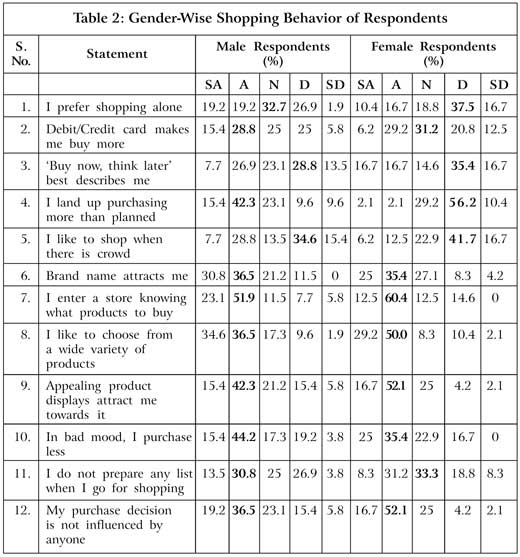
The occupation-wise analysis of shopping behavior of customers (Table 3) revealed that out of the total sample, 20.6% students preferred shopping alone which is almost double the response received from service class respondents where only 10% agreement was received for the statement of preference for shopping alone. For the statement "Debit/credit card makes me buy more" the highest level of agreement was received from the students (25%), followed by service class respondents (20% and then professionals (18%). Interestingly, the business class people did not show high level of agreement (9.1%) with the statement. Almost all the respondents from various occupations agreed that they landed up purchasing more than planned. Students agreed that they liked to shop where there is crowd (23.5%) unlike the respondents having their own businesses (9.1% agreement) and professionals (6% agreement). Business class people were very conscious of brand name and 40.9% agreed that brand name attracts them. This agreement to being attracted by brand name was 33.3% for service class people and 32.4% for the students. 46% of the professionals liked to choose and shop from a wide variety of products and 40% of the professionals agreed that appealing product displays attracted them while shopping, whereas only 22.7% of the business class respondents agreed to the statement of being attracted to appealing product displays. Occupation-wise difference in agreement level can be seen when it comes to preparation of a list before going for shopping. Here 25% students and 22.8% business class respondents agreed to the statement that they do not prepare a list before going for shopping.
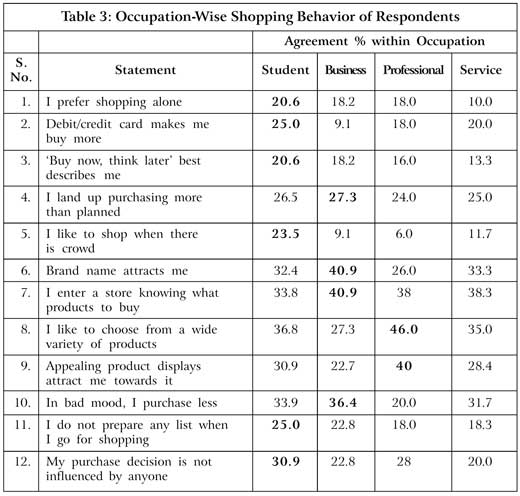
As seen in Table 4, 20.6% of the respondents in the income bracket of 20,000-35,000 and 19.2% respondents in the income bracket < 20,000, agreed that they preferred shopping alone. The agreement level for this statement was very low (8.4%) for those in the income bracket 35,000-50,000. Almost all the respondents in various income brackets except for those earning >50,000 per month agreed that the availability of debit/credit card made them buy more. A very similar agreement level (average of 24% agreement) was observed for the statement "I land up purchasing more than planned" for respondents in all income levels except for those in the income bracket of greater than 50,000 per month where 30.5% of the respondents agreed that they landed up purchasing more than planned.
19.2% of the respondents falling in the income bracket of < 20,000 per month agreed to the statement that they liked to shop when there is a crowd, whereas only 5.6% of the respondents in the income bracket greater than 50,000 per month and 8.9% of the respondents in the income bracket of 20,000-35,000 per month were in agreement with the statement that they enjoy shopping in crowded stores or locations. 41.7% of the respondents in the income bracket of 35,000-50,000 per month liked shopping where they can choose from a wide variety of products. 39% of the respondents in the same income bracket agreed that appealing product displays attracted them. This agreement percentage was much higher than that received from respondents in other income brackets.
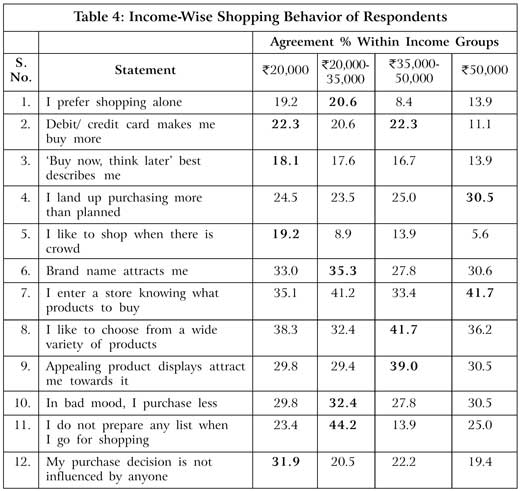
The age-wise shopping behavior in Table 5 points out that the respondents in the age group of 16-25 years (25.6% agreement level) land up purchasing more because of the availability of debit/credit card. This level of agreement is much higher than that received from other age groups. The respondents in the same age group (16-25 years) also exhibited a high level of agreement (22.1%) with the statement "Buy now think later best describes me". All the age group respondents exhibited a similar level of agreement (average 25% respondents agreed) with the statement that they landed up purchasing more than planned. The respondents in the age group of 16-25 years liked to shop (22.1% agreed) when there is a crowd while those in the age group of above 25 years did not like to shop when there is a crowd which is evident from their low level of agreement with the statement. 47.2% respondents in the age group of 36-45 years agreed that they entered the store knowing what products to buy. On the other hand, the average agreement level of respondents in other age groups was 35% for the same statement.
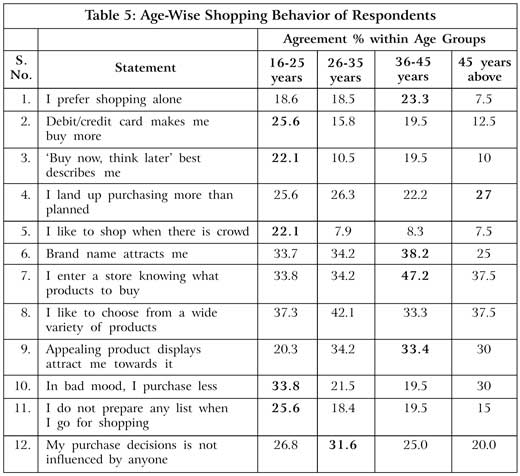
A scale was constructed to study the factors affecting the shopping behavior and purchase decision of the customers. The Cronbach’s Alpha value of 0.729 established the reliability of the scale. The KMO value of 0.63 in Table 6 points towards sampling adequacy and the Bartlett’s test of sphericity shows a significance value of 0.000 which is less than 0.05 at 95% confidence level. Therefore, the null hypothesis, "None of the variables are correlated," gets rejected and there is a clear indication that some of the variables have significant correlation among themselves. Therefore, it is good to carry out a factor reduction test.

Table 7 shows that 73.9% of the variance is explained by the seven factors. Thus, the 15 variables considered earlier are now reduced to seven dimensions/factors. The table also shows that 16.99% of the variance is explained by the first factor, 12.51% is explained by the second factor, 10.41% of the variance is explained by the third factor, 9.65% by the fourth factor, 8.55% by the fifth factor, 8.25% of variance is explained by sixth factor and finally 7.55% by the seventh factor.
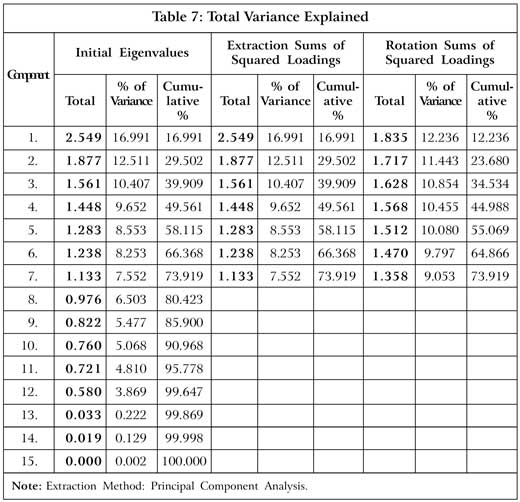
The Rotated Component Matrix (Table 8) depicts the loadings of the variables on the seven factors.
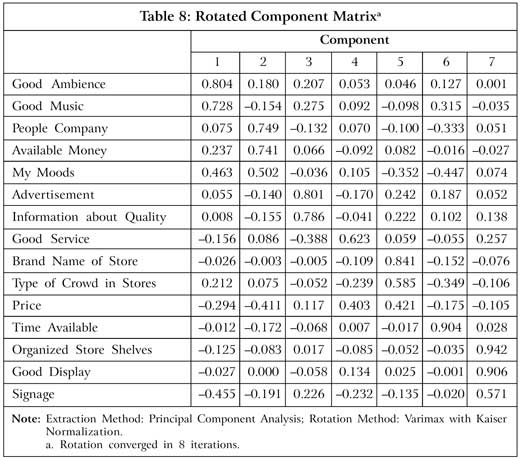
The factor loadings obtained from rotated component matrix table are summarized in Table 9.
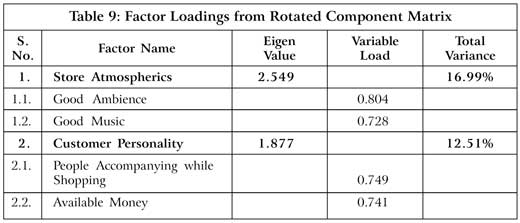
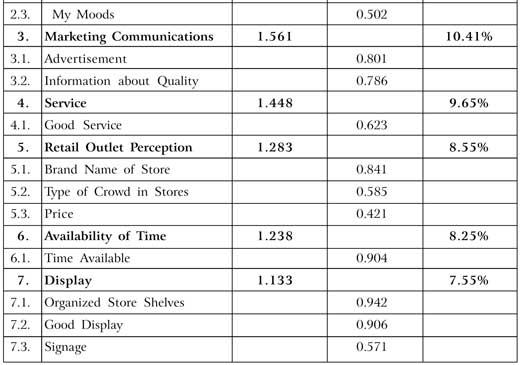
The seven factors extracted from exploratory factor analysis which overall contribute towards 73.91% variance in the consumer behavior towards purchase of mobile handsets are:
- Store Atmospherics
- Customer Personality
- Marketing Communications
- Service
- Retail Outlet Perception
- Availability of Time and
- Display
Conclusion
Store atmospherics, personal factors, marketing communications, service, retail outlet perception, time availability and display at the stores have been found to significantly affect the customer purchase behavior. Further, the demographic purchase behavior of customers can provide useful insights to marketers to design their customer acquisition and retention strategies so that they can increase their loyal customer base.
Limitation and Scope for Future Study
Consumers these days have a number of options like online portals, teleshopping, catalog shopping, etc. available from where they can shop. This study is limited to the study of shopping behavior of customers at retail stores. Future studies could be carried out to study the online versus offline shopping behavior of customers. A study involving a comparison of shopping behavior of different generations could also lead to valuable insights.
References
- Bashar A, Ahmad I and Wasiq M (2013), "A Study of Influence of Demographic Factors on Consumer Impulse Buying Behavior", Journal of Management Research, Vol. 13, No. 3, pp. 145-154.
- Bawa K and Ghosh A (1999), "A Model of Household Grocery Shopping Behaviour", Marketing Letters, Vol. 10, No. 2, pp. 149-160.
- Cobb C and Hoyer W (1986), "Planned versus Impulse Purchase Behavior", Journal of Retailing, Vol. 62, No. 4, p. 384.
- Dickson J P and MacLachlan D L (1990), "Social Distance and Shopping Behaviour", Journal of the Academy of Marketing Science, Vol. 18, No. 2, pp. 153-161.
- Graa A and elKabir D (2011), "Application of Stimulus and Response Model to Impulse Buying Behavior of Algerian Consumers", Serbian Journal of Management, Vol. 7, No. 1, pp. 53-64.
- Khan M, Humayun A and Sajjad M (2014), "Factors Affecting Impulse Buying and Percentage of Impulse Buying in Total Purchasing", International Journal of Information, Business and Management, Vol. 7, No.1, pp. 254-268.
- Meyer P (2001), "Brands Need to Understand Mindset of Echo-Boomers in Order to Survive", Kids Marketing Report, Vol. 1, No. 28, January, p. 14.
- Milliman R E (1982) "Using Background Music to Affect the Behaviour of Supermarket Shoppers", Journal of Marketing, Vol. 46, Summer, pp. 86-91.
- Mulligan G F (2010), "Consumer Demand and Multipurpose Shopping Behaviour", Geographical Analysis, Vol. 15, pp. 76-81.
- Rich S U and Jain S C (1968), "Social Class and Life Cycle as Predictors of Shopping Behaviour", Journal of Marketing Research, Vol. 5, pp. 41-49.
- Stern H (1962), "The Significance of Impulse Buying Today", Journal of Marketing, Vol. 26, No. 2, pp. 59-62.
- Taylor S L and Cosenza R M (2002), "Profiling Later Aged Female Teens: Mall Shopping Behavior and Clothing Choice", Journal of Consumer Marketing, Vol. 19, No. 5, pp. 393-408.
- Youn S and Faber R (2000), "Impulse Buying: Its Relation to Personality Traits and Cues", Advances in Consumer Research, Vol. 27, pp. 27-33.
